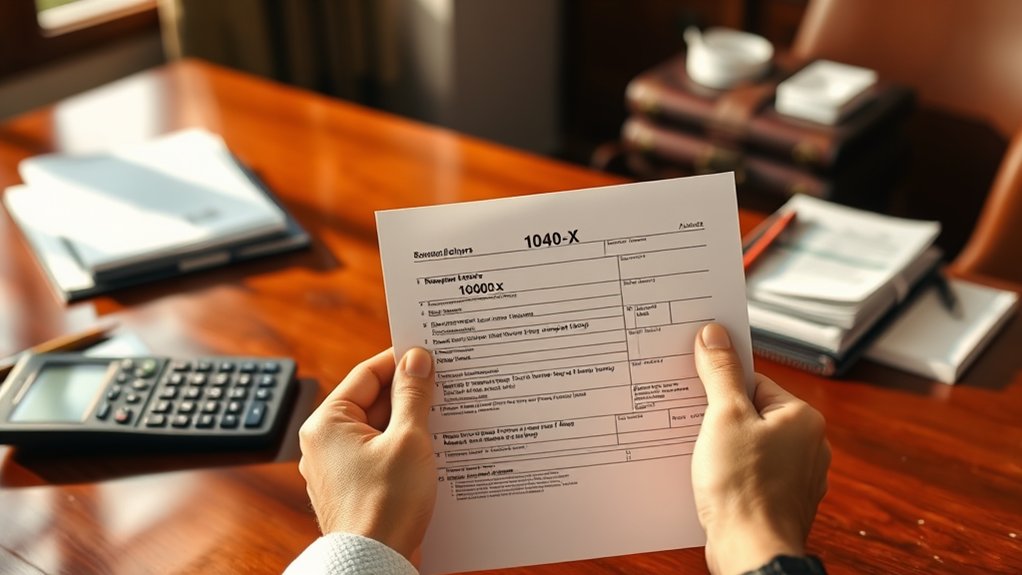To correct errors on your previously filed tax return, you’ll need to submit Form 1040-X, the Amended U.S. Individual Income Tax Return. Common situations requiring amendments include missing income, overlooked deductions, incorrect filing status, or misclaimed dependents. However, you don’t need to amend for simple math errors, as the IRS automatically corrects these. You must file within 3 years of your original filing date or 2 years from paying the tax. Understanding the specific requirements will guarantee proper correction of your return.
Common Reasons for Filing an Amended Return

While tax returns should be accurate when initially filed, several common situations necessitate submitting an amended return. I need to file Form 1040-X when I’ve discovered missing income from a W-2 or 1099, overlooked valuable deductions or credits, or used an incorrect filing status.
I must also amend if I claimed dependents incorrectly, made calculation errors that affect my tax liability, or received corrected information statements from employers or financial institutions. Additionally, I’ll file an amended return if I need to adjust my income, deductions, or credits based on recent IRS audits or tax law changes affecting previous years.
When You Don’t Need to File an Amendment
Although filing an amended return is sometimes necessary, certain errors don’t require Form 1040-X. If you made a math error, the IRS will automatically correct it and notify you of any adjustments. You also don’t need to amend for missing forms or schedules—the IRS will contact you if they need additional documentation.
Don’t file an amendment if you forgot to attach your W-2 or other income statements. The IRS already has these documents from your employer. Similarly, if you’re simply waiting for a delayed K-1 or corrected 1099, you can wait for the IRS to address any discrepancies through their automated matching system.
Understanding Form 1040-X

I’ll help you understand Form 1040-X, which the IRS requires for amending previously filed tax returns. You’ll need this form to correct errors, update your filing status, or modify income, deductions, and credits reported on your original return. While you can file Form 1040-X within three years of your original filing date or within two years of paying the tax, I recommend submitting it as soon as you discover an error that requires correction.
Purpose of Form 1040-X
Form 1040-X serves as the official IRS document for amending previously filed federal income tax returns. I’ll show you how this powerful tool lets you correct errors and make necessary adjustments to your tax situation.
| Common Reasons to File | Key Benefits |
|---|---|
| Report additional income | Claim missed deductions |
| Change filing status | Reduce audit risk |
| Fix math calculations | Update tax elections |
When I need to amend a return, I use Form 1040-X to report changes in my income, deductions, credits, or tax liabilities. This form enables me to maintain compliance while maximizing my tax position, whether I’m claiming a refund or correcting an underpayment.
When to File Amendments
Understanding the timing requirements for tax amendments helps maximize your chances of successful corrections. You must file Form 1040-X within three years from the date you filed your original return or within two years from the date you paid the tax, whichever is later.
I recommend filing your amendment as soon as you discover an error. Don’t wait until the deadline approaches. If you’re claiming a refund, filing promptly guarantees you’ll receive your money sooner. For amendments that require additional tax payments, quick filing helps minimize interest and potential penalties that accrue from the original due date.
Step-by-Step Process to Amend Your Return
The process of amending your tax return involves specific steps that must be followed precisely to guarantee proper correction of errors. I’ll walk you through the critical sequence: First, obtain Form 1040-X and your original return. Next, mark the tax year you’re amending and detail all corrections in Part III of the form. Calculate the revised figures and enter them in the appropriate columns. Include any supporting documentation that validates your changes. Sign and date the form. Finally, mail your amendment to the IRS processing center designated for your location. Don’t forget to retain copies for your records.
Time Limits and Deadlines for Amendments

If you need to amend your tax return, you must file Form 1040-X within three years from the date you filed your original return or within two years from the date you paid the tax, whichever is later. For back tax amendments, I recommend checking the specific tax year’s forms and instructions, as the IRS periodically updates its requirements. When claiming a credit or refund, you’ll need to file your Form 1040-X no later than three years after the due date of the original return, including extensions.
IRS Amendment Filing Deadlines
Filing an amended tax return requires careful attention to IRS deadlines and time limitations. I recommend filing Form 1040-X within three years from the date you filed your original return or within two years from when you paid the tax, whichever is later. If you’re claiming a refund, you must file your amendment before this three-year window closes. For returns filed early, I calculate the period starting from the actual due date. If you’re amending multiple years, I’ll remind you that each tax year requires a separate Form 1040-X, and you must mail them individually.
Back Tax Amendment Rules
Special rules govern back tax amendments when you need to correct returns from previous years. You must file Form 1040-X within three years from the date you filed your original return or within two years from the date you paid the tax, whichever is later. I recommend filing separate amendments for each tax year requiring correction.
For refunds, you’ll need to meet strict timing requirements. If you file your amendment after the three-year window, you can only claim a refund limited to taxes paid within the two years before filing the amendment. These deadlines are statutory and can’t be extended.
What to Expect After Filing Your Amendment
The tax return amendment process typically takes 8-16 weeks from the date the IRS receives your Form 1040-X. During this period, the IRS will review your changes, verify documentation, and process any refunds or payments due. You can track your amendment’s status online through the IRS “Where’s My Amended Return?” tool after three weeks from filing.
- Take control of your tax situation by maintaining copies of all amendment documents
- Assert your rights by responding promptly to any IRS inquiries about your amendment
- Protect your interests by documenting all communications with the IRS during processing
If the IRS requires additional information, they’ll contact you directly by mail.









